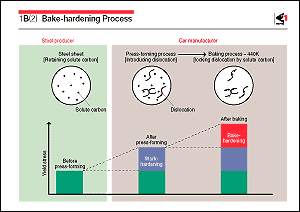One of the most important objectives
in the development of automotive steel sheet is the combination
of strength and formability. Formability is required when the
sheet is shaped into an automobile body panel, and high strength
is required after assembly. Bake-hardenable steel sheet was developed
by exploiting the fact that these two properties are not needed
simultaneously.
The lowest possible strength in an automotive steel sheet is
desirable for good formability when the sheet is subjected to
press forming; therefore, the carbon atoms in the steel sheet
are kept in the solid-solution condition. This can be accomplished
by rapid cooling of the steel sheet from high temperature during
the sheet production process, and this rapid cooling has become
industrially possible by the development of the continuous annealing
technique for strips. Before the development of the continuous
annealing technique, rapid cooling was impossible because annealing
of heavy coil with big heat capacity was conducted as a batch
process.
Dislocations are introduced by press forming a steel sheet, and
strength is increased by the action of work hardening in which
accumulated dislocations prevent the movement of other dislocations.
When an automobile body is being manufactured, painting and baking
are carried out after assembly. These processes involve heating
the steel body panels to about 443K (170 ). At this temperature,
the carbon atoms dissolved in the steel diffuse by jumping between
lattice points, which occurs 103 to 105 times a second, segregating
in the regions around dislocations where the stresses are compressive.
This results in locking of the dislocations which is called strain
aging. This mechanism makes the steel panels harder after baking
than after press forming, and is referred to as bake hardening.
The utilization of this bake hardening phenomenon has made it
possible to utilize steel sheet that has good formability during
press forming and that can withstand severe working, while being
hard and less prone to denting when assembled in the automobile
body. ). At this temperature,
the carbon atoms dissolved in the steel diffuse by jumping between
lattice points, which occurs 103 to 105 times a second, segregating
in the regions around dislocations where the stresses are compressive.
This results in locking of the dislocations which is called strain
aging. This mechanism makes the steel panels harder after baking
than after press forming, and is referred to as bake hardening.
The utilization of this bake hardening phenomenon has made it
possible to utilize steel sheet that has good formability during
press forming and that can withstand severe working, while being
hard and less prone to denting when assembled in the automobile
body. |
|
 |
 |
 |
|
|